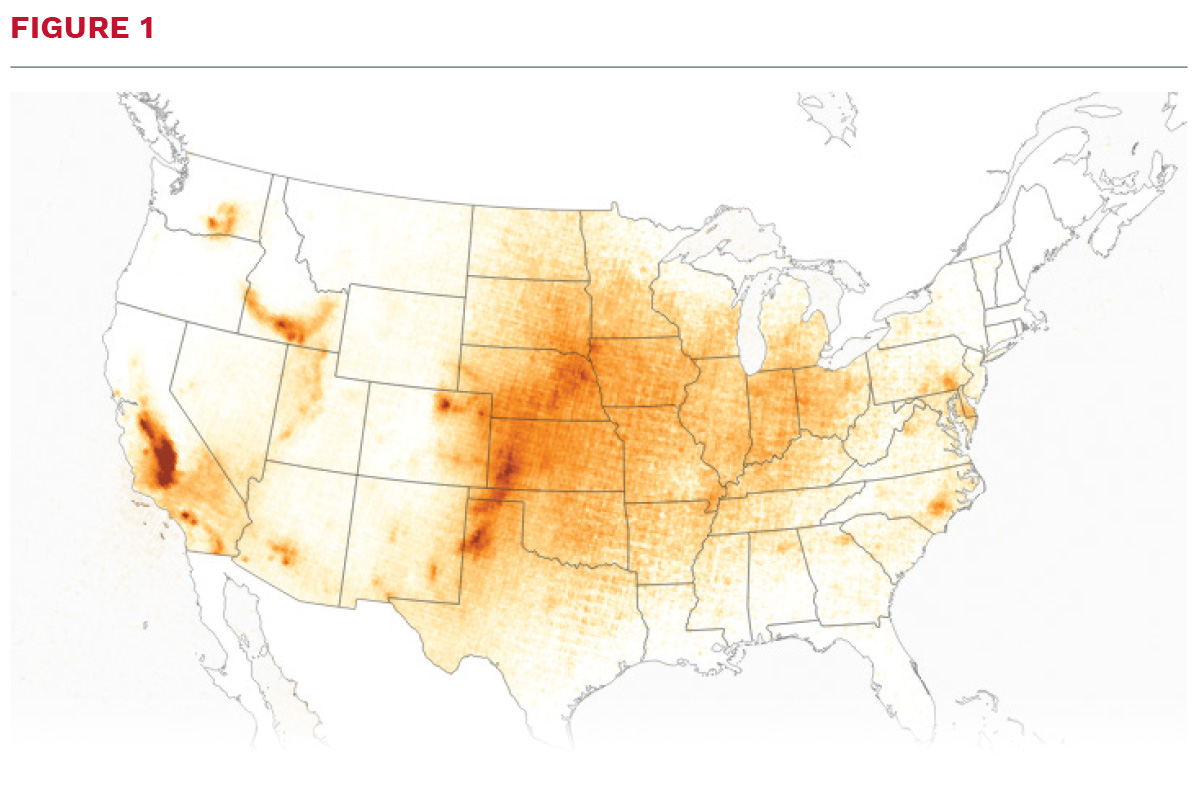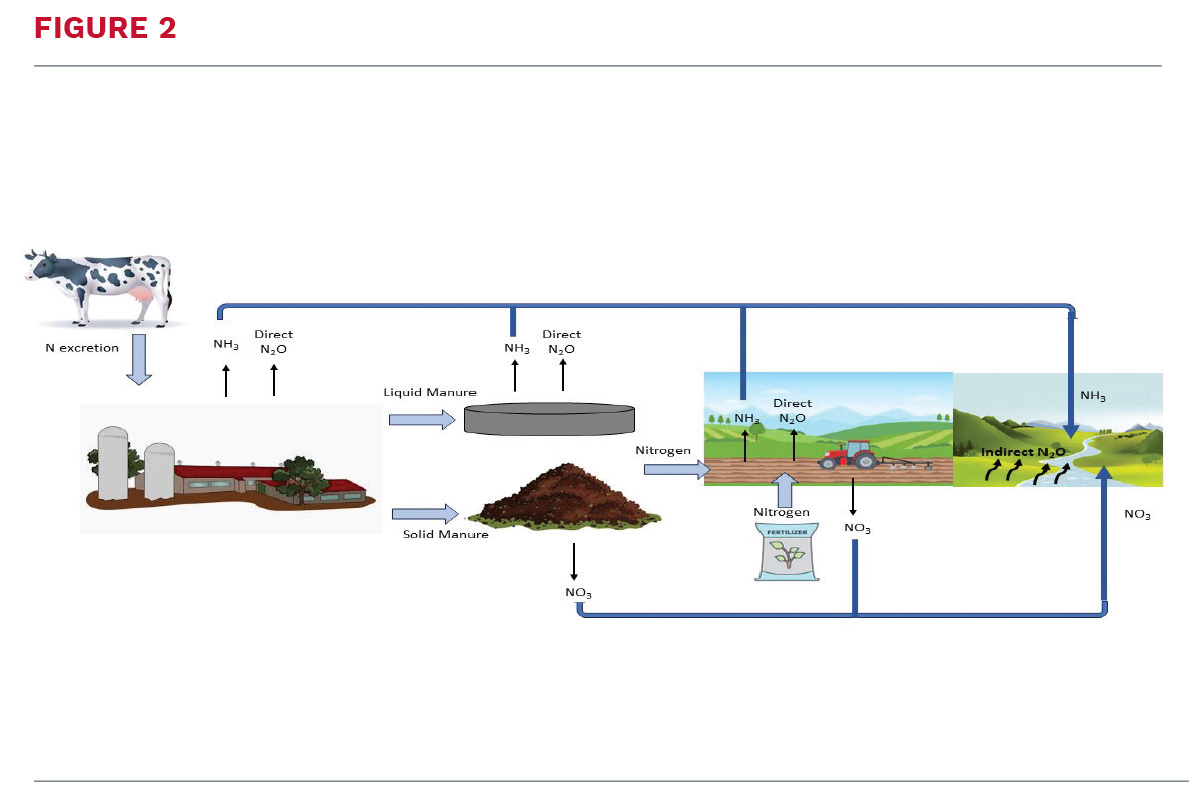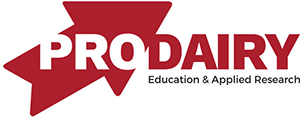Often, when people think about climate change and livestock production, they think about methane, as there has been a lot of focus on reduction of methane from both the cattle themselves (enteric) as well as from manure storage. But methane is not the only driver of climate change from livestock production. Reactive nitrogen (Nr), which includes all biologically, chemically, and radiatively active nitrogen compounds in the atmosphere and biosphere, can play an important role in climate change.
Nitrogen transforms and is lost through many pathways as it cycles through agricultural operations. The primary forms of Nr lost are ammonia (NH3), nitrate (NO3), nitrous oxide (N2O), and N oxides (NO and NO2 or NOx). This loss of Nr to the environment is of increasing concern as negative impacts on water, air quality, sensitive ecosystems, and climate can ultimately have negative consequences for human, animal and environmental health.
One of the main pathways of Nr losses from livestock production to the environment is through gaseous emissions, particularly NH3. In the U.S., 5.5 million tons of NH3 are generated each year, with about 83 percent of that originating from agriculture (U.S. EPA, 2020). Approximately 60 percent of U.S. agricultural emissions are generated from livestock production, with about 22 percent originating from dairy production. Figure 1 shows ammonia concentrations derived from satellite imagery across the U.S. and highlights the importance of agriculture and livestock production on ammonia emissions.

Credit: Visible Earth is part of the EOS Project Science Office at NASA Goddard Space Flight Center.
Feed N that is not utilized by animals is excreted in the feces and urine. For example, a lactating cow may excrete more than 70 percent of the N ingested in feed, with the majority excreted in urine. The majority of urinary N is in the form of urea, which upon excretion into the environment can be rapidly hydrolyzed to NH4+ by the urease enzyme found in feces and soil, and subsequently converted to NH3 and lost via volatilization.
Typical NH3 emissions rates from animal housing range from five to 50 percent of N excreted, depending on animal species, housing system, manure handling practices, diet, and climatic variables. An additional amount of NH3 can be lost during manure storage as well as land application of manure. The generation and emission of NH3 from manure is influenced by multiple factors, such as exposed manure surface area, airflow across manure surface, manure mixing, manure storage loading rate, ambient temperature, and manure age, temperature, moisture content, and pH.
In the atmosphere, NH3 reacts with acidic pollutants to form particulates (e.g., ammonium sulfate, ammonium bisulfate, ammonium nitrate), which contribute to PM2.5, climate forcing, and poor visibility. Ammonia may be removed from the atmosphere by dry or wet deposition, leading to elevated risks of soil acidification, reductions in vegetation species diversity, and eutrophication of aquatic ecosystems. Large regions of the world are currently experiencing N deposition rates that exceed 10 kg ha-1 yr-1, which is greater than an order of magnitude increase compared with natural rates. These deposition rates can have significant detrimental impacts to sensitive ecosystems.
The generation of N2O from dairy production systems has climate impacts as it is a greenhouse gas with a radiative forcing 265 times that of carbon dioxide. Generation of N2O occurs as N undergoes nitrification and denitrification processes. Nitrification is a process where bacteria in the manure or soil convert NH3 to nitrites and then NO3. During this transformation, small amounts of N2O are produced, which can be emitted to the atmosphere. Denitrification is a microbial process where nitrate is reduced to produce molecular N (N2). Incomplete denitrification processes occur though, producing N2O, which may escape to the atmosphere. The relative amounts of loss through these pathways are dependent upon many management and environmental conditions.
The emissions of N2O can be either “direct” or “indirect”. Direct emissions occur when N excreted from livestock (in housing and/or manure storage) or manure/fertilizer N applied to cropland undergo nitrification and denitrification processes that generate N2O. Indirect emissions occur when Nr is lost from the production system as NH3 or NO3 and are transported and deposited elsewhere in the landscape where it then undergoes these same processes, generating N2O. Inventory estimates suggest that indirect N2O emissions may account for as much as 20 percent of total N2O emissions. As dairy and other livestock operations generate a substantial amount of the anthropogenic NH3 emissions, the indirect N2O emissions associated with this NH3 can be significant.

Reducing Nr losses from livestock can help protect animal, human, and environmental health. Mitigation of reactive N loss from dairy operations must begin with feeding. Generally, about 20 to 30 percent of the protein N consumed by animals is retained in the animal products produced and the remainder is excreted. Feeding the right amount and quality of protein improves animal utilization and often improves production. This reduces the N excreted by the animal and often reduces the portion of that N excreted in a form such as urea which is readily transformed to NH3 and volatilized. Feeding animals in groups with similar nutrient requirements is one method to more accurately meet protein requirements. Feeding specific amino acids (types of protein) can also tailor diets to more accurately meet requirements. In ruminates, obtaining the right degradation of protein in the rumen and an appropriate bypass of protein to the intestinal tract is important, and feeding the right amounts and types of carbohydrates can also improve N utilization. Feeding well-balanced diets to maximize performance and N utilization is often the most cost-effective way to reduce N excretion and thus mitigate reactive N emissions from all manure-handling processes.
After N is excreted by the animal, steps can be taken to mitigate emissions during manure handling and storage. This can begin on the barn floor. By separating urine from feces, hydrolysis can be reduced, and the N is maintained in the less volatile form of urea. In dairy freestall barns, NH3 emissions have been reduced up to 50 percent by sloping floors to drain urine away from fecal material. When long-term manure storage is used, NH3 emissions from the storage can be reduced by up to 80 percent and N2O emissions can be eliminated by using a cover. Using a bottom-loaded slurry tank allows a natural crust to form on the surface. This is a cost-effective way to reduce NH3 emissions by about 70 percent, but nitrification and denitrification processes are enhanced, causing N2O emissions. When manure is applied to cropland, N losses are greatly reduced through rapid incorporation into the soil. Use of direct, subsurface injection of manure reduces NH3 emissions by 70 to 95 percent compared to that following broadcast application without incorporation, but the higher concentration of N in the soil may enhance nitrification and denitrification processes.
Nitrogen management strategies such as the 4R principles: right source, right rate, right time and right place, are being promoted to reduce fertilizer losses of N from cropping systems while maximizing crop uptake. These same principles apply to the use of manure nutrients in cropping systems. The use of complex crop rotations and cover crops to stabilize/utilize Nr in the soil system can also help reduce unintended losses.
Management to reduce N losses in animal production requires a whole-farm approach. Changes can be made to reduce N losses in each step of manure management between animal excretion and crop uptake. However, the benefit for reducing the loss in any one component is low if steps are not taken to reduce losses occurring in subsequent components. For example, reducing NH3 emissions in the housing facility has little benefit if that retained N is not maintained through improved management during manure storage and field application. Reducing NH3 emissions also may not provide overall benefit if that additional manure N leads to greater losses through denitrification and leaching. Only by providing similar levels of mitigation to animal feeding, housing, manure storage, and field application can production systems be developed with reduced or optimal environmental impact.
 |
This article appeared in PRO-DAIRY's The Manager in November 2023. To learn more about Cornell CALS PRO-DAIRY, visit PRO-DAIRY. |







